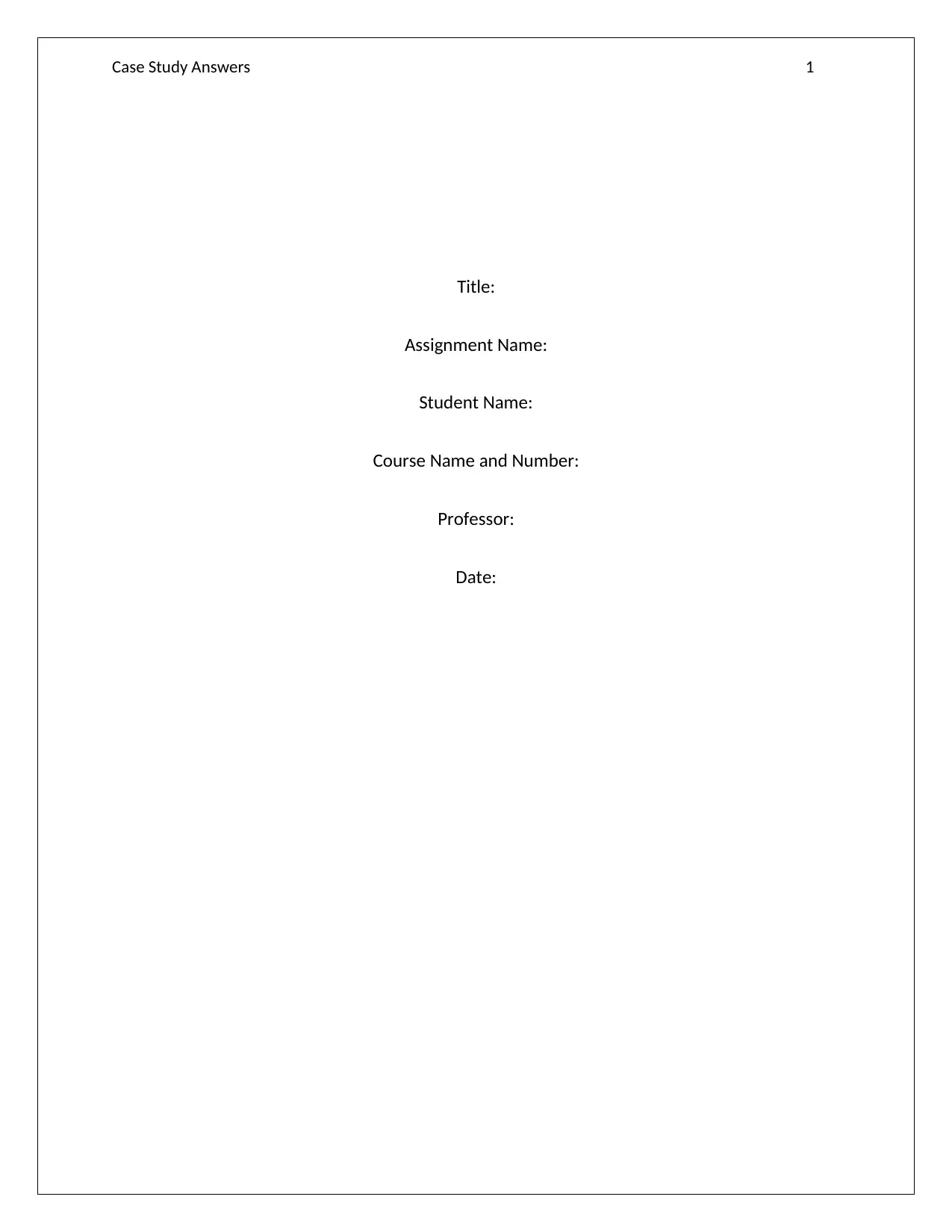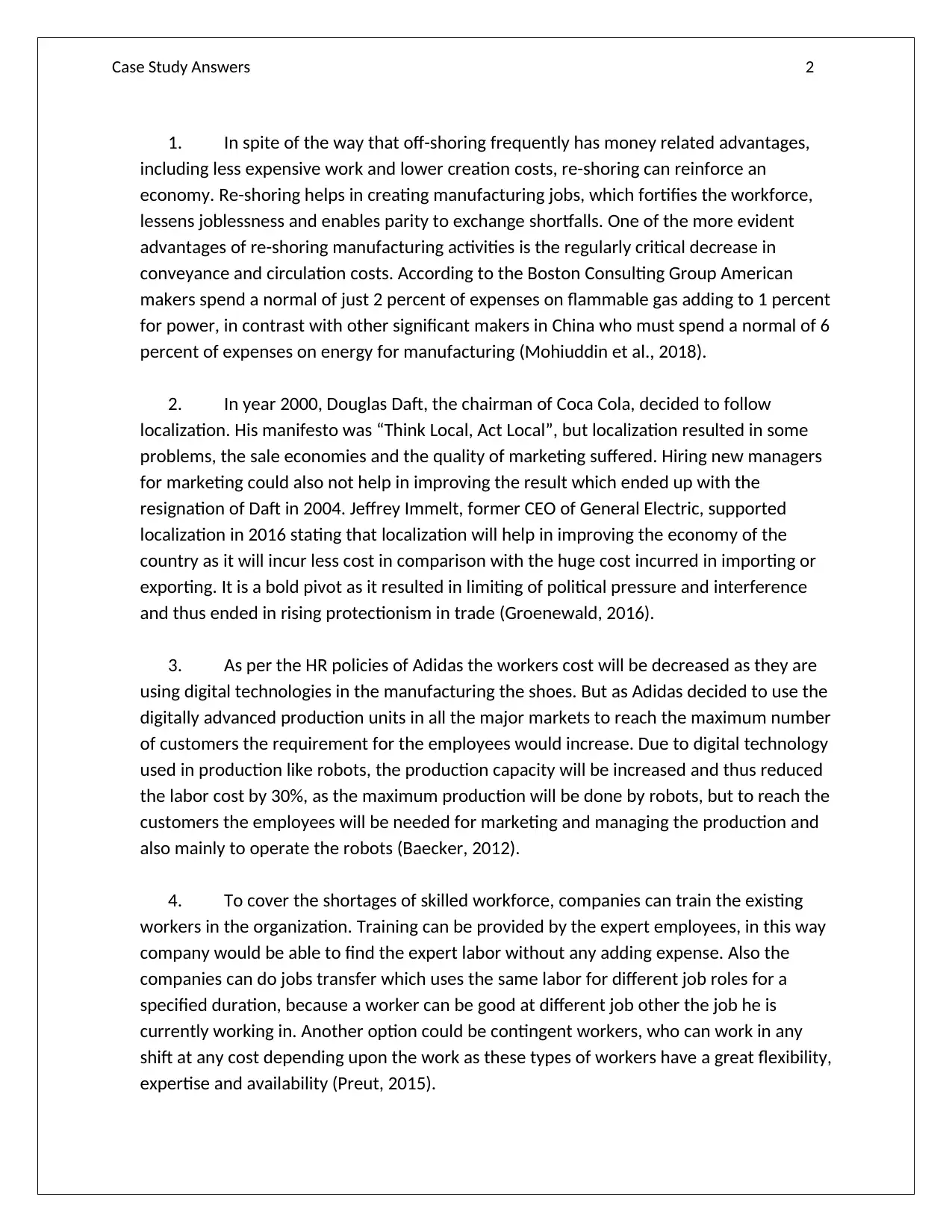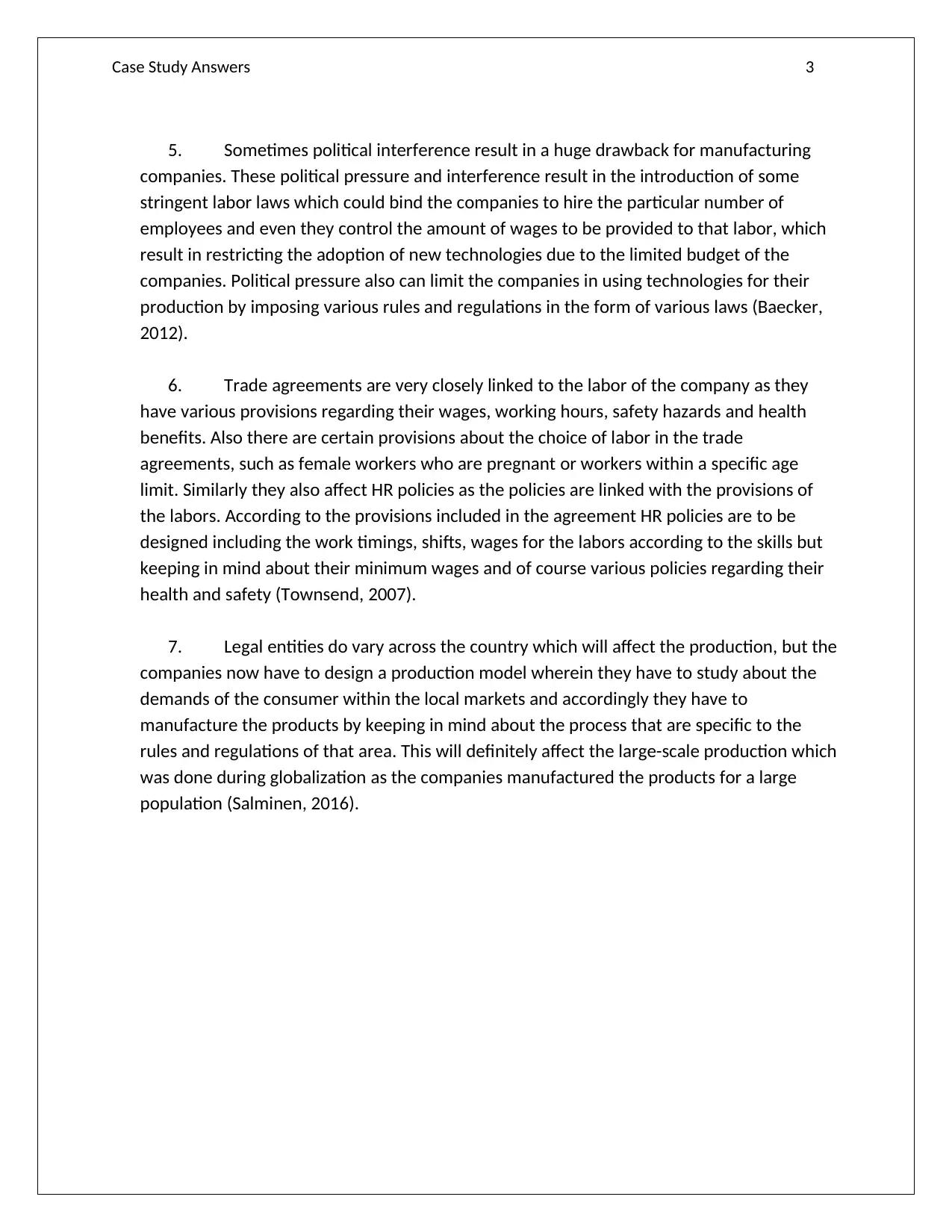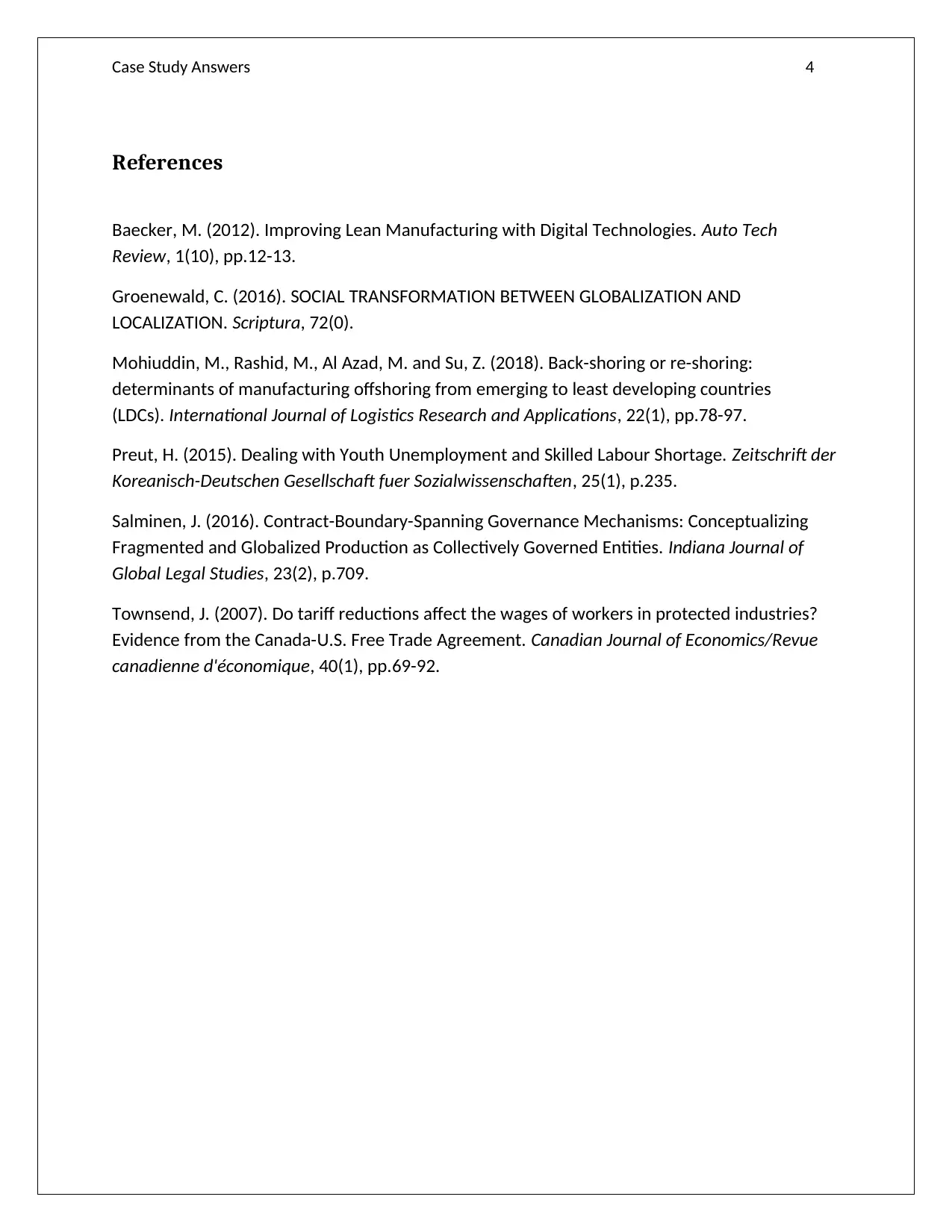University Case Study: Globalization, Business and Case Study Answers
VerifiedAdded on 2023/01/11
|4
|1094
|95
Case Study
AI Summary
This case study analyzes the multifaceted effects of globalization on businesses, exploring various aspects such as reshoring, localization, and the influence of political interference and trade agreements. The answers delve into the financial advantages of reshoring, contrasting them with the challenges faced by companies like Coca-Cola during localization efforts. The study further examines how companies like Adidas are adapting their HR policies in response to technological advancements and workforce shortages. It also addresses the impact of political pressures, labor laws, and trade agreements on manufacturing companies, and how legal entities and production models must adjust to local market demands. The case study provides insights into the complexities of global business operations and strategies for navigating the evolving global landscape.

Case Study Answers 1
Title:
Assignment Name:
Student Name:
Course Name and Number:
Professor:
Date:
Title:
Assignment Name:
Student Name:
Course Name and Number:
Professor:
Date:
Paraphrase This Document
Need a fresh take? Get an instant paraphrase of this document with our AI Paraphraser

Case Study Answers 2
1. In spite of the way that off-shoring frequently has money related advantages,
including less expensive work and lower creation costs, re-shoring can reinforce an
economy. Re-shoring helps in creating manufacturing jobs, which fortifies the workforce,
lessens joblessness and enables parity to exchange shortfalls. One of the more evident
advantages of re-shoring manufacturing activities is the regularly critical decrease in
conveyance and circulation costs. According to the Boston Consulting Group American
makers spend a normal of just 2 percent of expenses on flammable gas adding to 1 percent
for power, in contrast with other significant makers in China who must spend a normal of 6
percent of expenses on energy for manufacturing (Mohiuddin et al., 2018).
2. In year 2000, Douglas Daft, the chairman of Coca Cola, decided to follow
localization. His manifesto was “Think Local, Act Local”, but localization resulted in some
problems, the sale economies and the quality of marketing suffered. Hiring new managers
for marketing could also not help in improving the result which ended up with the
resignation of Daft in 2004. Jeffrey Immelt, former CEO of General Electric, supported
localization in 2016 stating that localization will help in improving the economy of the
country as it will incur less cost in comparison with the huge cost incurred in importing or
exporting. It is a bold pivot as it resulted in limiting of political pressure and interference
and thus ended in rising protectionism in trade (Groenewald, 2016).
3. As per the HR policies of Adidas the workers cost will be decreased as they are
using digital technologies in the manufacturing the shoes. But as Adidas decided to use the
digitally advanced production units in all the major markets to reach the maximum number
of customers the requirement for the employees would increase. Due to digital technology
used in production like robots, the production capacity will be increased and thus reduced
the labor cost by 30%, as the maximum production will be done by robots, but to reach the
customers the employees will be needed for marketing and managing the production and
also mainly to operate the robots (Baecker, 2012).
4. To cover the shortages of skilled workforce, companies can train the existing
workers in the organization. Training can be provided by the expert employees, in this way
company would be able to find the expert labor without any adding expense. Also the
companies can do jobs transfer which uses the same labor for different job roles for a
specified duration, because a worker can be good at different job other the job he is
currently working in. Another option could be contingent workers, who can work in any
shift at any cost depending upon the work as these types of workers have a great flexibility,
expertise and availability (Preut, 2015).
1. In spite of the way that off-shoring frequently has money related advantages,
including less expensive work and lower creation costs, re-shoring can reinforce an
economy. Re-shoring helps in creating manufacturing jobs, which fortifies the workforce,
lessens joblessness and enables parity to exchange shortfalls. One of the more evident
advantages of re-shoring manufacturing activities is the regularly critical decrease in
conveyance and circulation costs. According to the Boston Consulting Group American
makers spend a normal of just 2 percent of expenses on flammable gas adding to 1 percent
for power, in contrast with other significant makers in China who must spend a normal of 6
percent of expenses on energy for manufacturing (Mohiuddin et al., 2018).
2. In year 2000, Douglas Daft, the chairman of Coca Cola, decided to follow
localization. His manifesto was “Think Local, Act Local”, but localization resulted in some
problems, the sale economies and the quality of marketing suffered. Hiring new managers
for marketing could also not help in improving the result which ended up with the
resignation of Daft in 2004. Jeffrey Immelt, former CEO of General Electric, supported
localization in 2016 stating that localization will help in improving the economy of the
country as it will incur less cost in comparison with the huge cost incurred in importing or
exporting. It is a bold pivot as it resulted in limiting of political pressure and interference
and thus ended in rising protectionism in trade (Groenewald, 2016).
3. As per the HR policies of Adidas the workers cost will be decreased as they are
using digital technologies in the manufacturing the shoes. But as Adidas decided to use the
digitally advanced production units in all the major markets to reach the maximum number
of customers the requirement for the employees would increase. Due to digital technology
used in production like robots, the production capacity will be increased and thus reduced
the labor cost by 30%, as the maximum production will be done by robots, but to reach the
customers the employees will be needed for marketing and managing the production and
also mainly to operate the robots (Baecker, 2012).
4. To cover the shortages of skilled workforce, companies can train the existing
workers in the organization. Training can be provided by the expert employees, in this way
company would be able to find the expert labor without any adding expense. Also the
companies can do jobs transfer which uses the same labor for different job roles for a
specified duration, because a worker can be good at different job other the job he is
currently working in. Another option could be contingent workers, who can work in any
shift at any cost depending upon the work as these types of workers have a great flexibility,
expertise and availability (Preut, 2015).

Case Study Answers 3
5. Sometimes political interference result in a huge drawback for manufacturing
companies. These political pressure and interference result in the introduction of some
stringent labor laws which could bind the companies to hire the particular number of
employees and even they control the amount of wages to be provided to that labor, which
result in restricting the adoption of new technologies due to the limited budget of the
companies. Political pressure also can limit the companies in using technologies for their
production by imposing various rules and regulations in the form of various laws (Baecker,
2012).
6. Trade agreements are very closely linked to the labor of the company as they
have various provisions regarding their wages, working hours, safety hazards and health
benefits. Also there are certain provisions about the choice of labor in the trade
agreements, such as female workers who are pregnant or workers within a specific age
limit. Similarly they also affect HR policies as the policies are linked with the provisions of
the labors. According to the provisions included in the agreement HR policies are to be
designed including the work timings, shifts, wages for the labors according to the skills but
keeping in mind about their minimum wages and of course various policies regarding their
health and safety (Townsend, 2007).
7. Legal entities do vary across the country which will affect the production, but the
companies now have to design a production model wherein they have to study about the
demands of the consumer within the local markets and accordingly they have to
manufacture the products by keeping in mind about the process that are specific to the
rules and regulations of that area. This will definitely affect the large-scale production which
was done during globalization as the companies manufactured the products for a large
population (Salminen, 2016).
5. Sometimes political interference result in a huge drawback for manufacturing
companies. These political pressure and interference result in the introduction of some
stringent labor laws which could bind the companies to hire the particular number of
employees and even they control the amount of wages to be provided to that labor, which
result in restricting the adoption of new technologies due to the limited budget of the
companies. Political pressure also can limit the companies in using technologies for their
production by imposing various rules and regulations in the form of various laws (Baecker,
2012).
6. Trade agreements are very closely linked to the labor of the company as they
have various provisions regarding their wages, working hours, safety hazards and health
benefits. Also there are certain provisions about the choice of labor in the trade
agreements, such as female workers who are pregnant or workers within a specific age
limit. Similarly they also affect HR policies as the policies are linked with the provisions of
the labors. According to the provisions included in the agreement HR policies are to be
designed including the work timings, shifts, wages for the labors according to the skills but
keeping in mind about their minimum wages and of course various policies regarding their
health and safety (Townsend, 2007).
7. Legal entities do vary across the country which will affect the production, but the
companies now have to design a production model wherein they have to study about the
demands of the consumer within the local markets and accordingly they have to
manufacture the products by keeping in mind about the process that are specific to the
rules and regulations of that area. This will definitely affect the large-scale production which
was done during globalization as the companies manufactured the products for a large
population (Salminen, 2016).
⊘ This is a preview!⊘
Do you want full access?
Subscribe today to unlock all pages.

Trusted by 1+ million students worldwide

Case Study Answers 4
References
Baecker, M. (2012). Improving Lean Manufacturing with Digital Technologies. Auto Tech
Review, 1(10), pp.12-13.
Groenewald, C. (2016). SOCIAL TRANSFORMATION BETWEEN GLOBALIZATION AND
LOCALIZATION. Scriptura, 72(0).
Mohiuddin, M., Rashid, M., Al Azad, M. and Su, Z. (2018). Back-shoring or re-shoring:
determinants of manufacturing offshoring from emerging to least developing countries
(LDCs). International Journal of Logistics Research and Applications, 22(1), pp.78-97.
Preut, H. (2015). Dealing with Youth Unemployment and Skilled Labour Shortage. Zeitschrift der
Koreanisch-Deutschen Gesellschaft fuer Sozialwissenschaften, 25(1), p.235.
Salminen, J. (2016). Contract-Boundary-Spanning Governance Mechanisms: Conceptualizing
Fragmented and Globalized Production as Collectively Governed Entities. Indiana Journal of
Global Legal Studies, 23(2), p.709.
Townsend, J. (2007). Do tariff reductions affect the wages of workers in protected industries?
Evidence from the Canada-U.S. Free Trade Agreement. Canadian Journal of Economics/Revue
canadienne d'économique, 40(1), pp.69-92.
References
Baecker, M. (2012). Improving Lean Manufacturing with Digital Technologies. Auto Tech
Review, 1(10), pp.12-13.
Groenewald, C. (2016). SOCIAL TRANSFORMATION BETWEEN GLOBALIZATION AND
LOCALIZATION. Scriptura, 72(0).
Mohiuddin, M., Rashid, M., Al Azad, M. and Su, Z. (2018). Back-shoring or re-shoring:
determinants of manufacturing offshoring from emerging to least developing countries
(LDCs). International Journal of Logistics Research and Applications, 22(1), pp.78-97.
Preut, H. (2015). Dealing with Youth Unemployment and Skilled Labour Shortage. Zeitschrift der
Koreanisch-Deutschen Gesellschaft fuer Sozialwissenschaften, 25(1), p.235.
Salminen, J. (2016). Contract-Boundary-Spanning Governance Mechanisms: Conceptualizing
Fragmented and Globalized Production as Collectively Governed Entities. Indiana Journal of
Global Legal Studies, 23(2), p.709.
Townsend, J. (2007). Do tariff reductions affect the wages of workers in protected industries?
Evidence from the Canada-U.S. Free Trade Agreement. Canadian Journal of Economics/Revue
canadienne d'économique, 40(1), pp.69-92.
1 out of 4
Your All-in-One AI-Powered Toolkit for Academic Success.
+13062052269
info@desklib.com
Available 24*7 on WhatsApp / Email
![[object Object]](/_next/static/media/star-bottom.7253800d.svg)
Unlock your academic potential
Copyright © 2020–2025 A2Z Services. All Rights Reserved. Developed and managed by ZUCOL.
